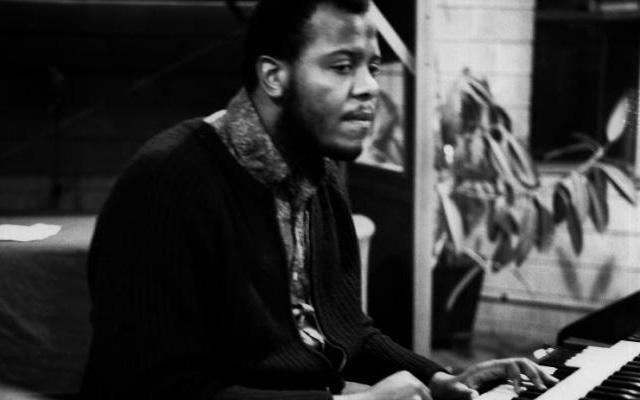Paris Eyes – Larry Young, Jr.
A post-bop swinger with a harmonic structure of mostly major chords. The AABC form is broken up by an extra measure in the second A section.
- Recording: Larry Young - Into Somethin'
- Recorded on: November 12, 1964
- Label: Blue Note (BLP 4187)
- Concert Key: F
- Vocal Range: , to
- Style: Swing (medium up)
- Tenor Sax - Sam Rivers
- Organ - Larry Young
- Guitar - Grant Green
- Drums - Elvin Jones
0:00
0:00
Buy MP3
Purchase Paris Eyes - Larry Young Jr.
Purchasing this song through our affiliate links with certain retailers provides jazzleadsheets.com with additional support to help keep us bringing you the best lead sheets available. Thank you!
Video
- Description
- Historical Notes
- Solos
- Piano Corner
- Bass Corner
- Drum Corner
- Guitar Corner
- Inside & Beyond
- Minus You
A medium-up swinger with a distinctively post-bop sound. The harmonic structure consists mostly of major chords, often shifting stepwise, with a few V-I resolutions that establish the key center. The A section begins with a simple melody outlining alternating F and E♭ major chords, descending further in the fifth measure. An ascending triplet line in the seventh measure outlines a resolution from D♭ major back to F.
The second A section adds a ninth measure at the end, touching on A major before modulating to A♭ for the bridge. This bridge holds longer notes in the melody while first alternating A♭ and G♭ chords, returning to F in the fifth measure and briefly modulating back to A♭ at the end with more fast ascending lines. The C section is essentially the same as the first A. The head form is kept in the solos, with the extra measure in the second A section.
On the recording, the organ and tenor sax play the melody in unison. The guitar also plays unison for some of the head, but adds a harmony part a third above on the first six measures of the A section as well as harmony below in the last two measures of the bridge. Note that the Guitar second part is available,
The second A section adds a ninth measure at the end, touching on A major before modulating to A♭ for the bridge. This bridge holds longer notes in the melody while first alternating A♭ and G♭ chords, returning to F in the fifth measure and briefly modulating back to A♭ at the end with more fast ascending lines. The C section is essentially the same as the first A. The head form is kept in the solos, with the extra measure in the second A section.
On the recording, the organ and tenor sax play the melody in unison. The guitar also plays unison for some of the head, but adds a harmony part a third above on the first six measures of the A section as well as harmony below in the last two measures of the bridge. Note that the Guitar second part is available,
"Into Somethin'" was recorded at the legendary Van Gelder Studio in Englewood Cliffs.
Larry Young went to Paris shortly after this recording. He recorded in Paris, and elsewhere in Europe, several times on both organ and piano from December 1964 to February 1965.
Drummer Elvin Jones played on two other important Blue Note albums in November 1964. On the 16th he was back in the studio with Larry and Grant Green, for the latter's album "Street Of Dreams"; Elvin also played on Joe Henderson's classic "Inner Urge" on November 30th.
Larry Young went to Paris shortly after this recording. He recorded in Paris, and elsewhere in Europe, several times on both organ and piano from December 1964 to February 1965.
Drummer Elvin Jones played on two other important Blue Note albums in November 1964. On the 16th he was back in the studio with Larry and Grant Green, for the latter's album "Street Of Dreams"; Elvin also played on Joe Henderson's classic "Inner Urge" on November 30th.
Paris Eyes provides fascinating insight into Grant Green's approach to parallel chord progressions. Faced with this series of parallel major chords, Green seems to be especially focused on addressing each chord, making extensive use of sequenced (transposed according to a progression) material as simple as the corresponding major triad. However, in outlining these changes, Green adds variety through frequent use of anticipation in his phrasing, often moving to a new chord on beat "4" or the "and" of "4" of the measure before.
Also of important note is Green's phrasing of the melody with Larry Young and Sam Rivers, as Green is careful to sync up every nuance of his articulation and phrasing with those of Young and Rivers, imbuing the simple melody with power.
Also of important note is Green's phrasing of the melody with Larry Young and Sam Rivers, as Green is careful to sync up every nuance of his articulation and phrasing with those of Young and Rivers, imbuing the simple melody with power.
Related Songs
Email Send Paris Eyes to a friend
Send this page to a friend via email. Add your name or email in the first field. In the second, add one or more email addresses, separated by a comma.

Larry Young, Jr.
October 7, 1940 – March 30, 1978
Larry Young was one of the most innovative jazz organists of all time. He was the first to develop an original voice on the organ in the post-bop and modal jazz style of the '60s. Later in that decade and into the '70s, he was instrumental in the development of fusion in his work with Miles Davis, John McLaughlin, and Tony Williams. Read more...
There was a problem.
...

